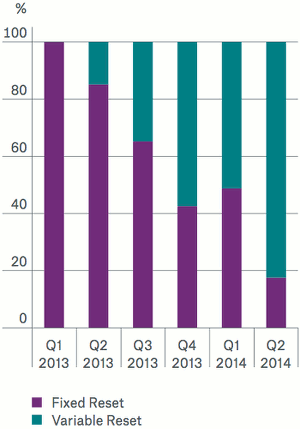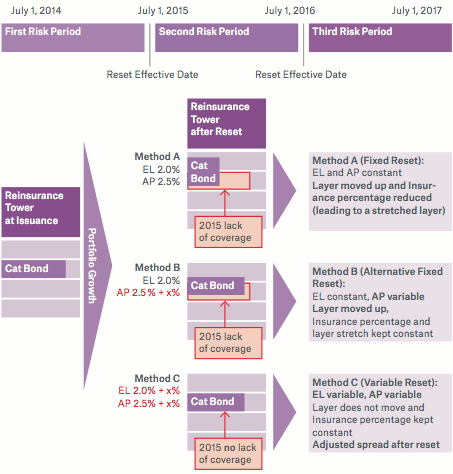One of the interesting developments to note in the catastrophe bond and insurance-linked securities (ILS) market in the last couple of years is the growth of sponsor-friendly structures, such as the variable reset.
The variable reset in a catastrophe bond, or ILS, deal, typically provides the cedent or sponsor with an option to adjust some of the key risk variables of the coverage provided by their cat bond or ILS at the annual reset.
Most variable resets are focused on allowing an adjustment of the attachment point, within specified risk and return limits. Adjusting the attachment point allows the ceding company to flex the coverage that its ILS or cat bond layer provides.
This is usually achieved by moving the attachment and exhaustion points, thus changing the location of the layer within a reinsurance tower. The attachment point can be moved within pre-defined bounds, usually defined by the attachment probability or expected loss having to remain within a specified range.
Once the layer has been adjusted there is typically a re-calculation of the coupon that is paid to investors, with investors being paid a higher coupon if the ceding insurer chooses to make the cat bond more risky, or a lower coupon if the deal is made less risky.
The variable reset can also be used to adjust the covered portfolio of a catastrophe bond. In some cases this could involve increasing the exposure to a specific peril, within an allowable range of expected loss, or even allowing the ceding insurer to include new regions into its catastrophe bond, as has been seen with some Florida focused start-ups which may like to expand nationally in the U.S. in years to come.
The world’s largest reinsurance company Munich Re’s Risk Trading unit provided a useful guide to the variable reset and the options available to ceding insurers in its latest ILS market report.
The first point of interest is the growing use and popularity of the variable reset mechanism in catastrophe bond issues over the last couple of years. The market has moved rapidly from almost all cat bond and ILS issues featuring a fixed reset to over 80% of ILS issuance in the bumper second-quarter of 2014 featuring a variable reset mechanism, as the graphic below shows.

Catastrophe bond & ILS fixed reset vs variable reset - Source: Munich Re
The growth in use of the variable reset has, of course, occurred in tandem with a decline in reinsurance, ILS and catastrophe bond pricing which has made the issuance of these instruments cheaper. Lower prices and higher competition, particularly between traditional reinsurers and the capital markets, means that ILS and cat bonds needs to provide features that narrow the gap between traditional and capital markets cover.
It has also occurred in tandem with growing investor appetite, as increasing numbers of institutional investors such as pension funds tried to access the asset class. These factors have made the growth of the variable reset much more pronounced, given the buyers market conditions that ceding insurers have benefited from in recent quarters.
Munich Re’s report also provides a good overview of the considerations when selecting the type of annual reset as well as the differences between the types of reset now available to cedents and sponsors. The diagram below from the report shows the different ways a cedent can elect t adjust the catastrophe bond coverage within their reinsurance programme tower.

Catastrophe bond annual reset options and differences - Source: Munich Re
Munich Re describes the catastrophe bond or ILS variable reset as follows:
In 2013, cat bonds were introduced to the market that provide the sponsor with the uni- lateral authority to move the cat bond layer, regardless of the modeled expected loss and attachment probability. In a growing portfolio scenario, this feature allows the sponsoring cedent to hold the cat bond layer constant, resulting in an increased expected loss and attachment probability (cp. Method C in figure above). However, the allowed difference between the initial modeled expected loss and the updated modeled expected loss is contractually limited, in order to reduce the extent of uncertainty for the investor. From the cedent’s perspective, holding the layer constant within a variable reset mechanism has the advantage that no coverage gaps or overlaps occur within the term of the bond, which reduces complexity around the alignment of the cat bond with the traditional part of the sponsor’s reinsurance tower.
In case the sponsor opts to increase the expected loss during the reset, a higher risk spread is due to investors subsequent to the reset. The updated risk spread is computed based on a predefined formula specified in the offering circular of the bond. The reset factor in the formula is applied to account for the expected incremental return requirement of investors for an additional unit of risk. In general, this factor is derived from current secondary market yields to reflect investor appetite for the bond’s particular risk / covered peril.
The development of the variable reset shows that the catastrophe bond market is becoming increasingly cedent friendly, seeking to provide coverage that benefits the sponsor, while allowing the investors to continue to have contractual certainty of the risk they are buying into.
We’d expect to see the variable reset, or at least elements of it, become a feature of almost every cat bond or ILS issued in future. It makes sense from the cedent point of view and as a result will likely become a common fixture of the majority of transactions.
You can find the full report from Munich Re over on its website here.
 View all of our Artemis Live video interviews and subscribe to our podcast.
View all of our Artemis Live video interviews and subscribe to our podcast.
All of our Artemis Live insurance-linked securities (ILS), catastrophe bonds and reinsurance video content and video interviews can be accessed online.
Our Artemis Live podcast can be subscribed to using the typical podcast services providers, including Apple, Google, Spotify and more.































